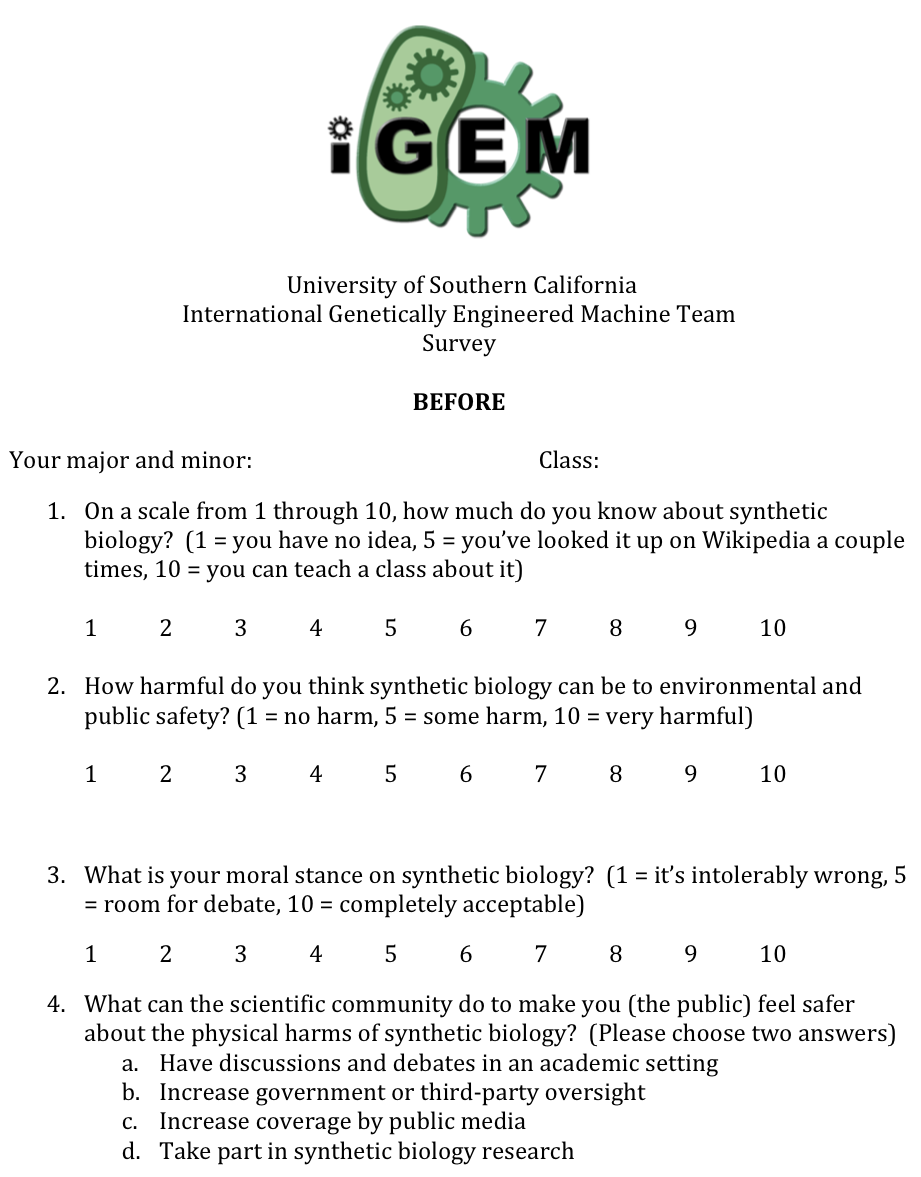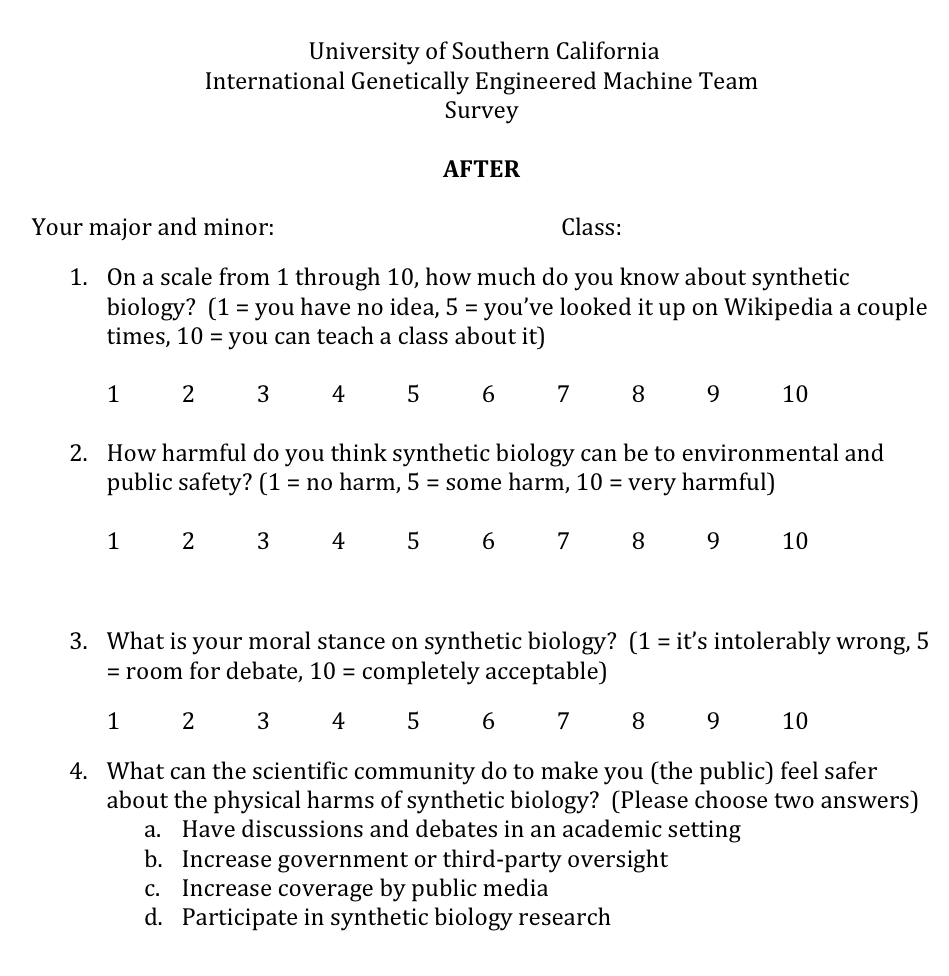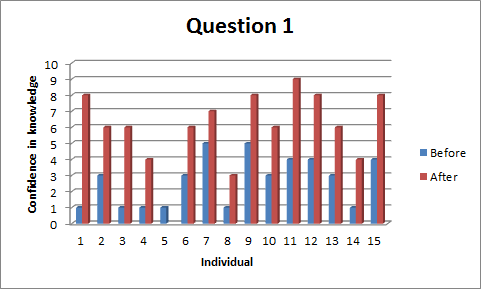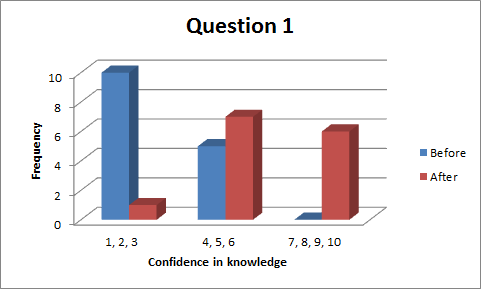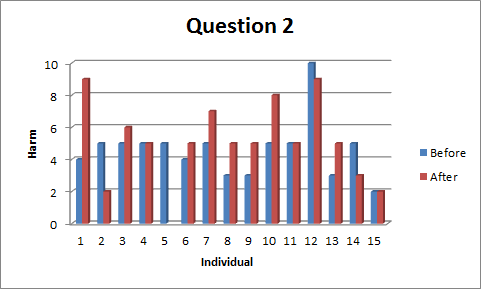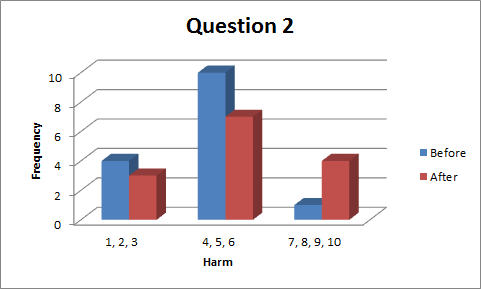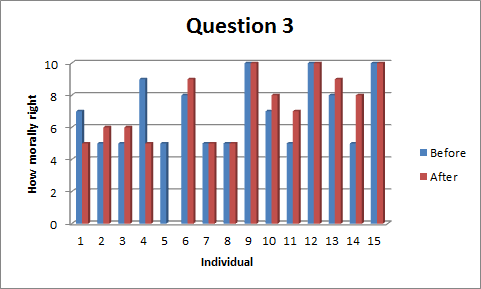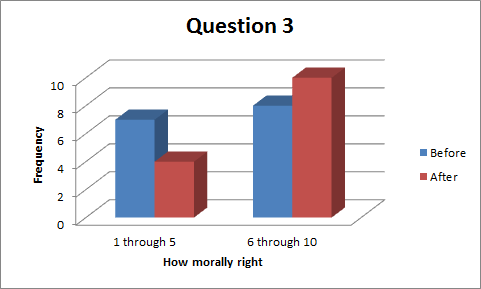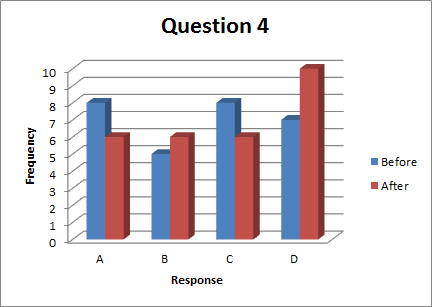Team:USC/Human Outreach
From 2011.igem.org
| (22 intermediate revisions not shown) | |||
| Line 1: | Line 1: | ||
| - | <table> | + | <table> |
| - | <!-- usc&igem logo --> | + | <!-- usc&igem logo --> |
| - | <tr> | + | <tr> |
| - | <td colspan=" | + | <td colspan="3">[[File:USC_Banner.jpg]]</td> |
| - | + | </tr> | |
| - | + | ||
| - | + | ||
| - | + | ||
| - | + | ||
| - | + | ||
| - | + | ||
| - | + | ||
| - | </tr> | + | |
| - | |||
| - | |||
| - | |||
| + | <tr> | ||
| + | <td colspan="3"> | ||
| - | < | + | <div style = "background: rgb(153,0,0);width: 954px;height: 36px;margin: 0 auto;padding: 0;"> |
| - | < | + | <ul> |
| + | <span style="float: left; padding: 15px;"><span style="font-family: Arial, Helvetica, sans-serif;font-size: 15px;font-weight: bold;color: #FFFFFF;border: none;">[[Team:USC|Home]]</span></span> | ||
| + | <span style="float: left; padding: 15px;"><span style="font-family: Arial, Helvetica, sans-serif;font-size: 15px;font-weight: bold;color: #FFFFFF;border: none;">[[Team:USC/Team|Team]]</span></span> | ||
| + | <span style="float: left; padding: 15px;"><span style="font-family: Arial, Helvetica, sans-serif;font-size: 15px;font-weight: bold;color: #FFFFFF;border: none;">[[Team:USC/Project|Project]]</span></span> | ||
| + | <span style="float: left; padding: 15px;"><span style="font-family: Arial, Helvetica, sans-serif;font-size: 15px;font-weight: bold;color: #FFFFFF;border: none;">[[Team:USC/Notebook|Notebook]]</span></span> | ||
| + | <span style="float: left; padding: 15px;"><span style="font-family: Arial, Helvetica, sans-serif;font-size: 15px;font-weight: bold;color: #FFFFFF;border: none;">[[Team:USC/Parts|Parts]]</span></span> | ||
| + | <span style="float: left; padding: 15px;"><span style="font-family: Arial, Helvetica, sans-serif;font-size: 15px;font-weight: bold;color: #FFFFFF;border: none;">[[Team:USC/Safety|Safety]]</span></span> | ||
| + | <span style="float: left; padding: 15px;"><span style="font-family: Arial, Helvetica, sans-serif;font-size: 15px;font-weight: bold;color: #FFFFFF;border: none;">[[Team:USC/Human Outreach|Human Outreach]]</span></span> | ||
| + | <span style="float: left; padding: 15px;"><span style="font-family: Arial, Helvetica, sans-serif;font-size: 15px;font-weight: bold;color: #FFFFFF;border: none;">[[Team:USC/Attributions|Attributions]]</span></span> | ||
| + | <span style="float: left; padding: 15px;"><span style="font-family: Arial, Helvetica, sans-serif;font-size: 15px;font-weight: bold;color: #FFFFFF;border: none;">[https://igem.org/Team.cgi?year=2011&team_name=USC Official Team Profile]</span></span> | ||
| + | </ul> | ||
| - | + | </div> | |
| - | + | ||
| - | + | ||
| - | + | ||
| - | + | ||
| - | + | ||
| - | + | ||
| - | + | ||
| - | + | ||
| - | + | ||
| - | + | ||
| - | + | ||
| - | |||
| + | </td> | ||
| + | </tr> | ||
| - | <tr> | + | <tr> |
| - | <td | + | <td style="width:100px; vertical-align:top;"> |
| - | + | ||
| - | + | ||
| - | + | <td style="width:724px;"> | |
| - | + | ||
| - | + | ||
| - | + | ||
| - | + | ||
| - | + | ||
| - | + | <h1 style="font-family:Verdana;font-weight:700;">Human Practices</h1> | |
| - | + | ||
| - | + | ||
| - | + | Although most iGEM members fully understand the concepts that drive synthetic biology, | |
| + | especially after applying our knowledge during summer research, we often forget how ignorant | ||
| + | we were of such topics before learning about them in class or even through iGEM. Caught up | ||
| + | in our own excitement of “doing science,” many of us do not consider the public’s awareness of | ||
| + | synthetic biology and its ethical or physical implications. Even our own iGEM members often | ||
| + | fail to realize the global or moral effects of synthetic biology on a broader scope. | ||
| - | + | The truth, however, is clear - synthetic biology is controversial. And we as the executors of | |
| + | synthetic biology, must educate the general public of the benefits and potential doubts of our | ||
| + | research so the public can take an informed stance on the issues of synthetic biology. | ||
| - | = | + | <h1 style="font-family:Verdana;font-weight:500;">Goal</h1> |
| - | + | To spread an understanding of what synthetic biology is and awareness of the advances and their socio-ethical implications. | |
| - | + | ||
| + | <h1 style="font-family:Verdana;font-weight:500;">How we did it</h1> | ||
| - | + | A discussion session was held where USC community members could learn about synthetic biology, learn about iGEM's role in synthetic biology, and discuss their views and concerns with others and the team. The discussion session began with a quick survey on the students’ current knowledge of synthetic biology. We then introduced our team and played a short | |
| + | video clip of background information on synthetic biology. | ||
| - | + | <html><center><object width="480" height="270"><param name="movie" value="http://www.youtube.com/v/rD5uNAMbDaQ?version=3&hl=en_US"></param><param name="allowFullScreen" value="true"></param><param name="allowscriptaccess" value="always"></param><embed src="http://www.youtube.com/v/rD5uNAMbDaQ?version=3&hl=en_US" type="application/x-shockwave-flash" width="480" height="270" allowscriptaccess="always" allowfullscreen="true"></embed></object></center></html> | |
| - | + | ||
| + | After the video, our team began our discussion about the effects and implications of synthetic biology. The students spoke of numerous benefits of synthetic biology, including discoveries of new antibiotics against malaria | ||
| + | and agricultural creations, such as the “grapple.” However, they also mentioned some worries about the effects of synthetic biology research on the development of biological weapons and even the possibility of creating a “super human.” Threats of bioterrorism and the sociopolitical implications of who should regulate and control these emerging technologies was a serious contention point. To conclude our meeting, we asked the students to fill out the same survey distributed in the beginning of the discussion to compare their opinions of synthetic biology after they participated in our discussion. | ||
| + | <h1 style="font-family:Verdana;font-weight:500;">Survey</h1> | ||
| - | + | [[File:igemsurveypage1r.png|400px|thumb|center]] | |
| - | [[File: | + | [[File:igemsurveypage2r.png|400px|thumb|center]] |
| - | |||
| + | |||
| + | |||
| + | |||
| + | |||
| + | <h1 style="font-family:Verdana;font-weight:500;">Results and Discussion</h1> | ||
| - | + | Presented are the results of the before and after surveys distributed at our discussion section. | |
| + | The top chart for each question shows each individual attendee's change from before the discussion to after the discussion. The bottom chart for each question shows the frequency of a certain response range (eg. 1-3, 4-6, 7-10). Question 4 only shows the total number of responses to each available choice. | ||
| - | + | ||
| + | |||
| + | <h1 style="font-family:Verdana;font-weight:300;">Question 1</h1> | ||
| + | '''On a scale from 1 through 10, how much do you know about synthetic biology? (1 = you have no idea, 5 = you've looked it up on Wikipedia a couple of times, 10 = you can teach a class about it)''' | ||
| + | |||
| + | |||
| + | [[File:Question1(confidence in knowledge).png|200px|thumb|right]] [[File:Question1(frequency).png|200px|thumb|right]] The charts to the right show the attendees' confidence in their knowledge about synthetic biology. Prior to the discussion each person was below a 5 (taken a quick peak at the Wikipedia page of synthetic biology). After the discussion, each person's confidence in their knowledge about synthetic biology grew by at least three. By looking at the frequency chart, people's responses are pooled within the range of 1 - 3, meaning most people had minimal to no knowledge about synthetic biology. After our discussion, the pooling of responses occurs in the higher two ranges. The before and after responses show a clear correlation that people's understanding and their confidence in their understanding of synthetic biology grew because of the discussion they participated in. | ||
| + | |||
| + | |||
| + | |||
| + | |||
| + | |||
| + | |||
| + | |||
| + | |||
| + | |||
| + | |||
| + | |||
| + | |||
| + | |||
| + | |||
| + | |||
| + | |||
| + | |||
| + | |||
| + | |||
| + | |||
| + | <h1 style="font-family:Verdana;font-weight:300;">Question 2</h1> | ||
| + | |||
| + | '''How harmful do you think synthetic biology can be to environmental and public safety? (1 = no harm, 5 = some harm, 10 = very harmful)''' | ||
| + | |||
| + | |||
| + | [[File:Question2(harm).png|200px|thumb|right]] [[File:Question2(frequency).png|200px|thumb|right]] The charts to the right show the attendees' perceptions of harm in the spheres of the environment and public safety. Prior to the discussion each person's perception of the harm that could be perpetrated by synthetic biology was minimal - this could be in part that most attendees did not understand the goals of synthetic biology and what the practice of synthetic biology entails (synthetic biology is not evil!!!) After our discussion, to our surprise, on average, people's perceived potential harm that synthetic biology could perpetrate actually increased! Our discussion, though focused on beneficial uses and practices, such as agriculture, novel antibiotic generation, and iGEM did inevitably focus on negative aspects of synthetic biology, such as bioterrorism, environmental contamination of mutated organisms, potential for eugenics, and reduction of genetic diversity. It became evident that these are concerns that the public, whether educated or not educated about synthetic biology, have in regards to its practice and rapid progression. | ||
| + | |||
| + | |||
| + | |||
| + | |||
| + | |||
| + | |||
| + | |||
| + | |||
| + | |||
| + | |||
| + | |||
| + | |||
| + | |||
| + | |||
| + | |||
| + | |||
| + | |||
| + | <h1 style="font-family:Verdana;font-weight:300;">Question 3</h1> | ||
| + | ''' What is your moral stance on synthetic biology? (1 = it's intolerably wrong, 5 = room for debate, 10 = completely acceptable) ''' | ||
| + | |||
| + | [[File:Question3(moral).png|200px|thumb|right]] [[File:Question3(frequency).png|200px|thumb|right]] The charts to the right show the attendees' moral/ethical stance on synthetic biology before and after our discussion. The general trend is that attendees' became morally accepting of synthetic biology after our discussion. An interesting observation occurs when comparing the results of Question 2 and this one. Though the responses to Question 2 indicate that many of the attendees perceived synthetic biology to be more harmful after the discussion, many students moral acceptance of synthetic biology grew after the discussion. This apparent dichotomy can be due to the rationale that though inherent risks exist with the usage and propagation of synthetic biology; if administered and practiced to better humanity in an contemporary ethical manner, the benefits may outweigh the risks. The morality and ethical nature of synthetic biology is not an issue that can be laid to rest - it will continue to be a contentious point of discussion by the evolving nature of morality and the rapid progress that synthetic biology is making. | ||
| + | |||
| + | |||
| + | |||
| + | |||
| + | |||
| + | |||
| + | |||
| + | |||
| + | |||
| + | |||
| + | |||
| + | |||
| + | |||
| + | |||
| + | |||
| + | |||
| + | |||
| + | <h1 style="font-family:Verdana;font-weight:300;">Question 4</h1> | ||
| + | ''' What can the scientific community do to make you (the public) feel safer about the physical harms of synthetic biology?''' | ||
| + | |||
| + | ''' A. Have discussions and debates in an academic setting ''' | ||
| + | ''' B. Increase government or third-party oversight ''' | ||
| + | ''' C. Increase coverage by public media ''' | ||
| + | ''' D. Take part in synthetic biology research ''' | ||
| + | |||
| + | [[File:Question4(choices).png|300px|thumb|right]] This question was asked to gauge the effectiveness of the discussion - whether students would potentially like to have more or see more of them (choice A). The general trend however showed that after the discussion, the desire for further academic discussion decreased. After the discussion there was a slight increase in the desire for more governmental oversight/regulation - this could be due in part to the topics focused on in Question 2 and Question 3. A result that pleased the entire team were attendees' desire to actually participate and become immersed in synthetic biology research markedly increased. This increase could be due to their new found understanding and knowledge of synthetic biology. By actually seeing it in practice they could better understand the intent of its use, its capabilities, and potentially can further educate the public about synthetic biology. | ||
| + | |||
| + | |||
| + | |||
| + | |||
| + | |||
| + | |||
| + | |||
| + | |||
| + | <h1 style="font-family:Verdana;font-weight:500;">Future Directions</h1> | ||
| + | |||
| + | Stimulating conversations on synthetic biology often take place during presentations and panel discussions, but a more uncharted territory--social media--may prove to be just as, if not more, effective. Social media houses millions of members, from middle school students to elderly citizens, and scope of sites such as Facebook allow even the most trivial comments to become viral. If the synthetic biology community could somehow tap into this reservoir of media exposure, topics such as the benefits, harms, and even ethicality of synthetic biology would be more openly discussed. | ||
| + | |||
| + | Sites like Twitter and Facebook are great platforms for synthetic biology discussion; Twitter could be used for announcing news on the latest developments or instigating debates, while Facebook could be used for spreading interest and information on current issues or holding even surveys. | ||
| + | To access the Twitter link, click here: http://twitter.com/#!/USCiGEM | ||
| + | |||
| + | A problem of using social media for synthetic biology discussions, however, is the difficulty of keeping a user’s attention for an extended period of time needed to educate the public and receive feedback. A person who attends a conference or presentation about synthetic biology is more likely to pay attention than a person seated in front of a computer with complete control over closing a web browser in seconds. | ||
| + | |||
| + | Our iGEM team members, who are well aware of this issue, decided to run an experiment on which was more effective and cost-efficient: holding a time-consuming and costly presentation or encouraging self-education through social media, of which we have no control over. The ongoing experiment can be found through this link: https://www.facebook.com/event.php?eid=146435558785326 | ||
| + | |||
| + | Because social media is an ongoing process and can change over a long period of time, we will keep the social media page open and will continue to collect data there. As we receive more information through social media, we will compare our Facebook analyses to our presentation results and prove the benefits and flaws of using both in-person discussion and online conversations. | ||
Latest revision as of 03:03, 29 September 2011
 |
||
|
||
Human PracticesAlthough most iGEM members fully understand the concepts that drive synthetic biology, especially after applying our knowledge during summer research, we often forget how ignorant we were of such topics before learning about them in class or even through iGEM. Caught up in our own excitement of “doing science,” many of us do not consider the public’s awareness of synthetic biology and its ethical or physical implications. Even our own iGEM members often fail to realize the global or moral effects of synthetic biology on a broader scope. The truth, however, is clear - synthetic biology is controversial. And we as the executors of synthetic biology, must educate the general public of the benefits and potential doubts of our research so the public can take an informed stance on the issues of synthetic biology. GoalTo spread an understanding of what synthetic biology is and awareness of the advances and their socio-ethical implications. How we did itA discussion session was held where USC community members could learn about synthetic biology, learn about iGEM's role in synthetic biology, and discuss their views and concerns with others and the team. The discussion session began with a quick survey on the students’ current knowledge of synthetic biology. We then introduced our team and played a short video clip of background information on synthetic biology.
Survey
Results and DiscussionPresented are the results of the before and after surveys distributed at our discussion section. The top chart for each question shows each individual attendee's change from before the discussion to after the discussion. The bottom chart for each question shows the frequency of a certain response range (eg. 1-3, 4-6, 7-10). Question 4 only shows the total number of responses to each available choice.
Question 1On a scale from 1 through 10, how much do you know about synthetic biology? (1 = you have no idea, 5 = you've looked it up on Wikipedia a couple of times, 10 = you can teach a class about it)
Question 2How harmful do you think synthetic biology can be to environmental and public safety? (1 = no harm, 5 = some harm, 10 = very harmful)
Question 3What is your moral stance on synthetic biology? (1 = it's intolerably wrong, 5 = room for debate, 10 = completely acceptable) The charts to the right show the attendees' moral/ethical stance on synthetic biology before and after our discussion. The general trend is that attendees' became morally accepting of synthetic biology after our discussion. An interesting observation occurs when comparing the results of Question 2 and this one. Though the responses to Question 2 indicate that many of the attendees perceived synthetic biology to be more harmful after the discussion, many students moral acceptance of synthetic biology grew after the discussion. This apparent dichotomy can be due to the rationale that though inherent risks exist with the usage and propagation of synthetic biology; if administered and practiced to better humanity in an contemporary ethical manner, the benefits may outweigh the risks. The morality and ethical nature of synthetic biology is not an issue that can be laid to rest - it will continue to be a contentious point of discussion by the evolving nature of morality and the rapid progress that synthetic biology is making.
Question 4What can the scientific community do to make you (the public) feel safer about the physical harms of synthetic biology? A. Have discussions and debates in an academic setting B. Increase government or third-party oversight C. Increase coverage by public media D. Take part in synthetic biology research This question was asked to gauge the effectiveness of the discussion - whether students would potentially like to have more or see more of them (choice A). The general trend however showed that after the discussion, the desire for further academic discussion decreased. After the discussion there was a slight increase in the desire for more governmental oversight/regulation - this could be due in part to the topics focused on in Question 2 and Question 3. A result that pleased the entire team were attendees' desire to actually participate and become immersed in synthetic biology research markedly increased. This increase could be due to their new found understanding and knowledge of synthetic biology. By actually seeing it in practice they could better understand the intent of its use, its capabilities, and potentially can further educate the public about synthetic biology.
Future DirectionsStimulating conversations on synthetic biology often take place during presentations and panel discussions, but a more uncharted territory--social media--may prove to be just as, if not more, effective. Social media houses millions of members, from middle school students to elderly citizens, and scope of sites such as Facebook allow even the most trivial comments to become viral. If the synthetic biology community could somehow tap into this reservoir of media exposure, topics such as the benefits, harms, and even ethicality of synthetic biology would be more openly discussed. Sites like Twitter and Facebook are great platforms for synthetic biology discussion; Twitter could be used for announcing news on the latest developments or instigating debates, while Facebook could be used for spreading interest and information on current issues or holding even surveys. To access the Twitter link, click here: http://twitter.com/#!/USCiGEM A problem of using social media for synthetic biology discussions, however, is the difficulty of keeping a user’s attention for an extended period of time needed to educate the public and receive feedback. A person who attends a conference or presentation about synthetic biology is more likely to pay attention than a person seated in front of a computer with complete control over closing a web browser in seconds. Our iGEM team members, who are well aware of this issue, decided to run an experiment on which was more effective and cost-efficient: holding a time-consuming and costly presentation or encouraging self-education through social media, of which we have no control over. The ongoing experiment can be found through this link: https://www.facebook.com/event.php?eid=146435558785326 Because social media is an ongoing process and can change over a long period of time, we will keep the social media page open and will continue to collect data there. As we receive more information through social media, we will compare our Facebook analyses to our presentation results and prove the benefits and flaws of using both in-person discussion and online conversations. |
||
 "
"
